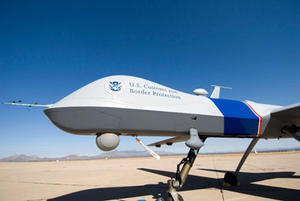BusinessDefense companies turn their attention to border security
The U.S. involvement in the Iraq war is over, and the country will soon withdraw its troops from Afghanistan. Federal budgets cuts shrink agencies’ ability to conduct research and development. Faced with these realities, military contractors have begun to focus on border security. What many defense companies find especially appealing is the fact that the Senate immigration bill conditions any move toward legalizing the status of more than eleven million illegal immigrants in the United States on the strengthening of security along the U.S.-Mexico border.

UAVs are not the only military hardware used for border security // Source: asipress.ir
The U.S. involvement in the Iraq war is over, and the country will soon withdraw its troops from Afghanistan. Federal budgets cuts shrink agencies’ ability to conduct research and development. Faced with these realities, military contractors have begun to focus on border security.
What many defense companies find especially appealing is the fact that the Senate immigration bill conditions any move toward legalizing the status of more than eleven million illegal immigrants in the United States on the strengthening of security along the U.S.-Mexico border.
There is a debate among senators on how to measure border security, but the Senate Judiciary Committee approved a draft of the immigration reform bill which defines the border security benchmark as having an “effective control” and “persistent surveillance” of the entire border with Mexico. Once in place, the security measures must be able to apprehend or turn back 90 percent of people trying to cross the border.
The New York Times reports that DHS will submit a plan to Congress, showing the $4.5 billion allocated to border security in the immigration reform bill will be divided among various technologies — long-range cameras, radar systems, mobile surveillance equipment, aircraft, and lower-tech solutions such as border agents and physical fences.
“There are only so many missile systems and Apache attack helicopters you can sell,” Dennis Hoffman, an Arizona State University economics professor told the New York Times. “This push toward border security fits very well with the need to create an ongoing stream of revenue.”
Hoffman wrote a study on technology companies and border security.
Lockheed Martin, General Dynamics, Raytheon, and other companies are gearing up to show DHS their military-grade radar and long-range camera systems during an event this summer in order to win border security contracts which could be worth $1 billion.
“It has been a tough time for the industry: people have been laid off or furloughed,” James Creaghan, a lobbyist who represents a small Texas company, Personal Defense, which is trying to sell more night-vision goggles to Homeland Security, told the Times. “This could help out.”
Northrop Grumman, for example, is talking to DHS officials about the company’s automated tracking device, which was used by the Pentagon to search for roadside bombs in Afghanistan. NG wants DHS to use the technology with drones to track illegal border crossers.
NG however, has gained support on Capitol Hill. Senator Thomas Carper, (D- Delaware), the chairman of the Homeland Security and Governmental Affairs Committee has urged DHS to invest in NG’s surveillance system.
Critics say the government is too focused on high-technology solutions to the problem of illegal immigration, and that the money which is going to border security technology would achieve more elsewhere.
C. Stewart Verdery Jr., a former Homeland Security official who now runs a lobbying firm, says that federal officials should focus their resources on making it harder for illegal immigrants to work in the United States.
“Where are you going to get the biggest bang for the buck?” Verdery told theTimes. “Enforcement of the workplace is probably the best area to invest more dollars.”
